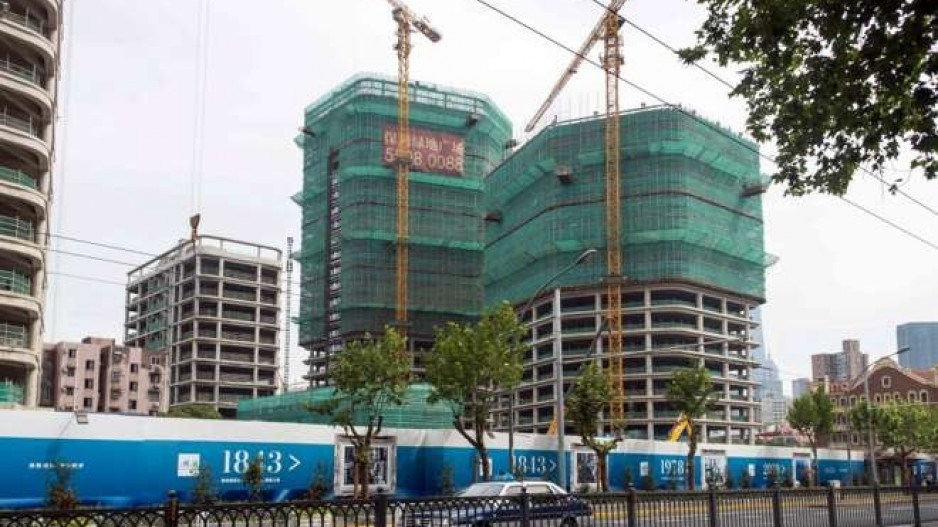Risks of a property bubble are growing in mainland China’s major cities, observers say.
New home prices have risen more than 30 per cent year on year among first-tier and a few second-tier cities. In August, Xiamen, a coastal city on the mainland side of the Taiwan Strait, saw prices rise 44 per cent. Similar increases were also seen in Hefei, Nanjing, Shenzhen, Shanghai, Beijing and Tianjin.
In some cities, the prices are approaching levels seen in New York, London and Hong Kong. A three-room flat measuring 266 sq metres at a development called Purple Palace in Beijing goes for 31.9 million yuan, which will take 375 years for a Beijinger with an average annual salary of 85,038 yuan to pay off.
Signs of panic buying are already emerging. A China Vanke project in suburban Beijing sold out overnight.
In Shenzhen, where August home prices jumped 37 per cent year on year, some units as small as 6 sq metres were offered for sale. Nine of them, at a price of 880,000 yuan each, all sold out within the day, the Guangzhou Daily said.
On Sunday, Nanjing city government announced further homebuying restrictions. Effective from Monday, non-Nanjing resident households who already own one or more new properties will also be prohibited from buying any new flats or any units in the secondary market.
Resident households who own two flats or more are banned from buying any new flats.
Previously, officials there introduced a lottery system for land sales because developers had become so eager to acquire plots regardless of the price, while in Hefei, where home prices rose 40.5 per cent year on year, saw flats sold at an average of between 20,000 yuan and 30,000 yuan per square metre.
“In the first half of 2015, prices there were just a little more than 10,000 yuan,” said Wang Min, who works for a property website in the city.
How to solve China’s property bubble
The market frenzy was “the most extreme” since 1998, when then premier Zhu Rongji privatised the housing market, said Shen Jianguang, chief economist of Mizuho Securities Asia in Hong Kong and a veteran Chinese economy watcher. “It’s abnormal especially when the economy is facing downward pressure and corporate profitability is weak,” he said.
Shen also compared the situation to Japan in the late 1980s, when that country’s property market overheated amid broad economic weakness. Mainland authorities might still have leeway to prevent a Japan-style crash of the housing market, he said.
Andy Xie, former Morgan Stanley economist, said China’s shadow banking sector gave buyers access to loans that effectively meant zero down payments, creating risks similar to what was seen in the United States before the subprime crisis.
“This is the same as zero down-payment mortgages in the US before 2008,” said Xie, who has been warning about bubble risks in the mainland’s housing market for years.
Tightening measures having little effect on surging property prices
Money is flowing into real estate in such volume partly as a result of the sheer scale of the monetary base, which is almost twice as big as the economy. But investment options are limited and outbound investment channels restricted, leaving a flood of yuan chasing returns at home amid a weakening economy.
Fang Jing, a Hefei resident who bought three flats in the city a few years ago, said most of the units were bought by non-Hefei residents.
“Even as an outsider, the rising home price is quite scary for me,” he said.
A decade ago when he bought homes, prices were just more than 3,000 yuan, he added.
Housing stock in Hefei takes 1.3 months to clear, the lowest inventory among the 35 cities tracked by E-house China R&D Institute. The price growth was bolstered by the surging land prices as the country’s major developers have been flocking to buy sites in the lower-tier cities amid limited land supply in first-tier cities.
A plot near city government was acquired by Sunac China Holdings a year ago at a record price of 17,000 yuan per square metre, and now units on the site are being sold at 30,000 and 35,000 yuan per square metre.
The property market is also being pumped by the relaxation of bank credit. As government and corporate debt quickly rises to dangerous levels, Beijing is trying to boost household debt levels to help stimulate growth.
In August, the amount lent out for home mortgages rose more than 500 billion yuan over the previous month, the second-largest increase of the year, according to central bank data.
Climbing prices in China’s big cities pose a tricky issue for the monetary authority – it can’t afford to tighten monetary policy as that would hurt the fragile economic recovery. If it continues with a loose monetary stance, speculation in the property market will persist, according to Wei Yao, China economist at Societe Generale.
“In every cycle in the past, housing and general inflation only ceased after the People’s Bank of China started tightening monetary policy,” Yao wrote in a note. “It will be tricky, to say the very least, if housing inflation cannot be arrested before growth loses momentum again, possibly by the end of 2016.”
For the moment, the property market fever remains restricted to dozens of cities and their surrounding areas, with 17 cities out of China’s 70 biggest cities reporting double-digit price growth in August, according to official data.
Nationwide, the household leverage ratio is still low. Wang Tao, chief China economist at UBS Group, wrote in a recent research note that prices in a few large cities had hit record levels of nearly 20 years’ annual income.
It was still premature to worry about an imminent burst because the frenzy has “not yet spread to a great many cities, pushed household debt to unsustainable levels or led to strong construction growth”.




